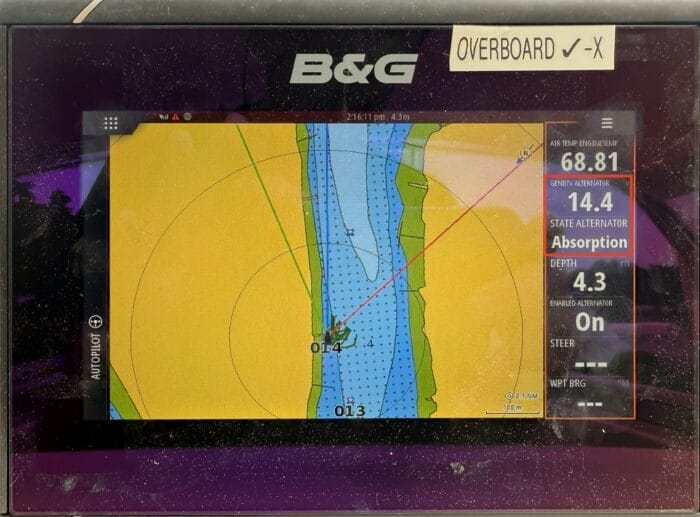
I was reprogramming the Wakespeed WS500 Pro alternator regulator yesterday, to take advantage of the whitespace feature—more on that in a step-by-step guide by Eric Klem, all written, edited, and coming late this month.
While I was at it, I was able to display the charging voltage and mode the regulator is in (bulk, absorption, or float) on our on-deck plotter, as shown in the photo above.
Sure, given that Al Thomason at Wakespeed kindly arranged for us to get a replacement Pro regulator with Bluetooth for evaluation, I could see the same information on the app (and a whole lot more), but that would require me screwing with my phone, which I think is distracting when underway and therefore bad practice.
And of course those with the older WS500s (without Bluetooth) will find this doubly useful.
Login to continue reading (scroll down). Paid membership required:
I was able to do the same, connecting the WS500 to my Raymarine chartplotter via the canbus plug. Rigging the bespoke cable was not all that difficult. Just needed an NMEA 2000 pigtail and canbus pigtail, then wired the two together. Yes, paying attention to pin-wire assignments. No special pin tools required. Worked well, once set up.
Hi Randall,
Thanks for the fill on that. I had not thought of using two pigtails to avoid needing special tools…duh! Which sentences were you able to display on the Raymarine. Any luck with alternator temperature?
John,
That was a few years back, on our prior boat. I can’t remember all of which sentences displayed. Not as many as cited in the manual. Certainly volts and RPM. Certainly not alternator temp, nor batt temp, which was disappointing. Two key data points, I thought. I wonder now if that was limited as much by the Raymarine MFD engine pages as by the WS500 connection or NMEA. I will be looking to set this up on our new good old boat, but that’s months away yet.
Hi Randall,
Thanks for the fill. I think you are right, both you and I are being limited by the abilities of the plotters to display less common NMEA 2K sentences.
Looking at my Raymarine manual for Axiom +, amongst other parameters, for Engine, it states Alternator PGN127487 can be read on the Axiom, but it is only voltage. PGN127487 is called “Engine Parameters Dynamic” and the available protocol data within that group, only Alternator Volts (0-100V) is available, at 1 second interval, nothing else is listed for alternators in that group. It looks to me that it is not a limit of the plotters but rather the protocol. I am quite ignorant in this field, so could very well be wrong, but I have started to try and understand where all my data is coming from. For example, I recently fitted a pressure transducer and expected a trend line on the Axiom, but it only shows a single pressure reading.
Hi Alastair,
Yes, some of the sentences that the WS500 can send are not supported by NMEA 2000—the WS500 uses RV-C, a much more complete and powerful protocol that NMEA2000 as it’s base and then provides translation of some sentences to NMEA2000.
That said most all the ones we want are translated and output (see WS500 manual linked above and I checked this with Al), including ones my B&G plotter won’t show so I think it’s a mix of limitations and the limitations of plotters are different for each brand, I’m pretty sure.
I have always found knowing the charging mode is very valuable. No matter if it is an alternator or traditional charger. I think of it as “what does the charging source think it is doing”? You mentioned Iinferring that the alternator had de rated do to temperature. I have also used this to note FLOAT with too high of associated voltage indicating a regulator failure. I had a manufacturer tell me that they were not over charging because the unit clearly said it was in FLOAT. And I pointed out that FLOAT would never be 14.6v. If all we new was the voltage we would have suspected the unit was still in bulk. I like to know what it thinks it is doing and compare that to what the results are.
Hi Carl,
As a young friend is want to say “Totally!”. I too, some years ago, was saved from a bad situation (self inflicted in my case) by having voltage displayed on deck.
We’ve done something similar with Digital Yacht’s veKonvert attached to the back of our Victron BMV-712. It allows us to see (i) the house battery state of charge, (ii) the current going into (or out of) the house battery, and (iii) and the voltages of the house and start batteries on our B&G chartplotter (Zeus 3).
This approach does not show the regulator stage, but on the other hand it does show the SoC and all of the data is available whether we are using the alternator or shore power to charge.